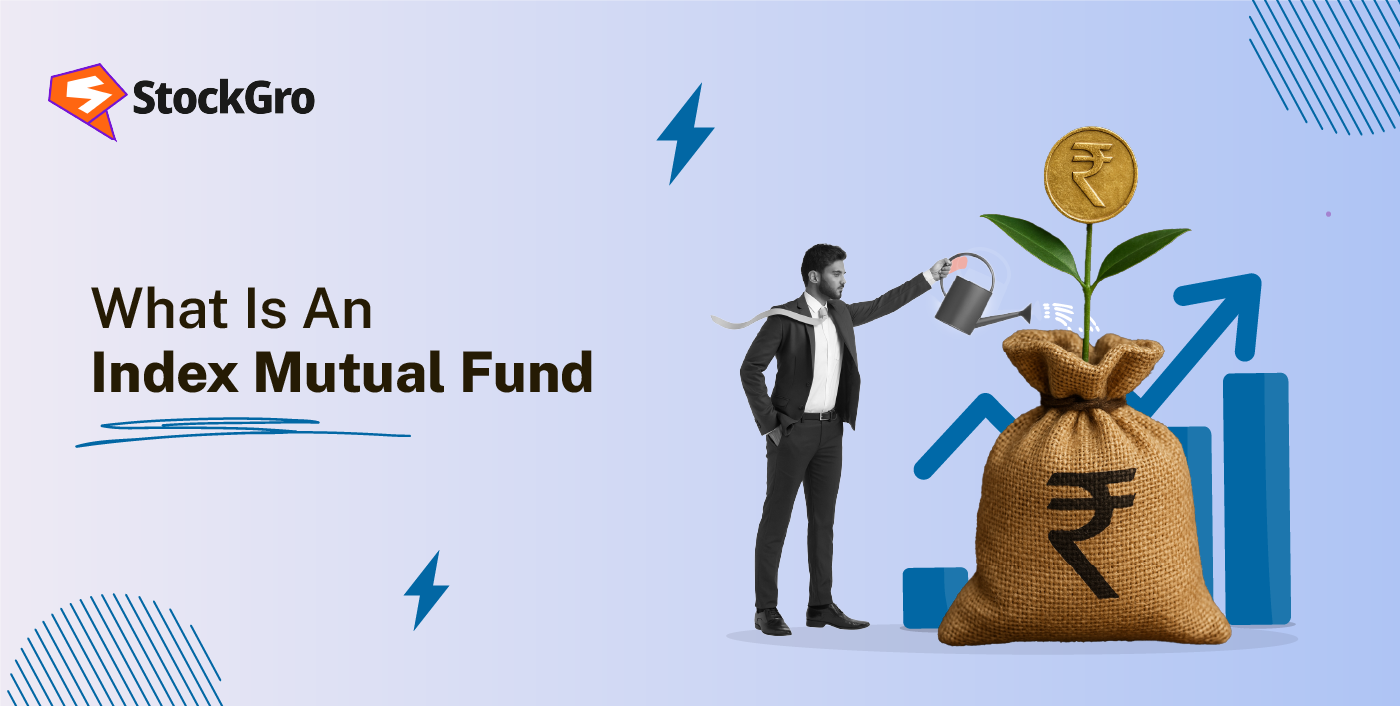
Did you know that as of 2022-23, mutual funds contribute 6% to the household sector’s gross financial savings, a jump from 0.9% in 2011-12. With rising incomes and an enhanced understanding of investments, households are investing in tools like mutual funds, a shift from traditionally preferred fixed deposits. Among mutual funds, one category is also gaining popularity- passive funds.
Passive funds are of two types: Index funds and Exchange-traded funds. This blog explores how index funds operate and differ from actively managed funds, their benefits, risks, and suitability.
What is an Index Mutual Fund?
An Index mutual fund is a passive fund that imitates stock market index like NSE nifty, BSE index to get the similar performance of its chosen benchmark. They invest in accordance with the benchmark. Stock selection and portfolio allocation are based on the benchmark. The aim is to closely follow the benchmark, to generate returns that match it.
Do you want to invest in a market index of your choice? The only way to do that is through an index fund. For example, if you wish to invest in the Nifty Midcap150 Index, you can invest in index funds tracking it, such as the Tata Nifty Midcap150 Index fund, Motilal Oswal Nifty Midcap150 Index fund, HDFC Nifty Midcap150 Index fund, and others.
How Do Index Mutual Funds Work?
While index funds are passive, they do require a fund manager to manage the portfolio. However, fund managers follow the investment allocation that the benchmark has already put forward. This means the fund manager does not have the liberty to pick new stocks or invest according to their discretion. For example, if an index invests in the shares of 10 different companies, the index fund tracking it cannot invest in a different 11th company.
The index fund’s composition remains nearly the same as the index. Any fresh inflows or redemptions are adequately invested or liquidated to maintain the index’s composition. Many indices rebalance semi-annually or quarterly. Index fund managers need to track any changes in the index and rebalance their allocations accordingly.
Here’s a list of steps involved in the process of investing in index funds:
| Step | Details |
| Picking a benchmark | A fund manager chooses a benchmark that they want to track. For example, broader market indices like Nifty50 or BSE Sensex. Narrow market indices like Nifty Midcap150 or BSE IT. |
| Portfolio construction | The fund’s portfolio is allocated based on the chosen benchmark’s portfolio construction. |
| Tracking the benchmark | The index fund’s manager needs to monitor the index and any changes in its portfolio. |
| Maintain portfolio composition | If the index updates its portfolio composition, the index fund must replicate these changes to ensure its holdings remain aligned with the index. |
Examples of Some Popular Index Mutual Funds in India
Some of the popular index mutual funds in India are:
| Fund name | Tracking benchmark | AUM (As of 31st July, 2025) |
| UTI Nifty50 Index Fund | Nifty 50 | ₹23,731 Crores |
| ICICI Prudential Nifty Next 50 Index Fund | Nifty Next 50 | ₹7,691 Crores |
| Motilal Oswal Nifty India Defence Index Fund | Nifty India Defence | ₹3,495.93 Crores |
| Nippon India Nifty Midcap 150 Index Fund | Nifty Midcap 150 | ₹1,857.41 Crores |
| SBI Nifty Smallcap 250 Index Fund | Nifty Smallcap 250 | ₹1,495.47 Crores |
Difference Between Index Funds and Actively Managed Funds
Let’s have a look at the key differences between an index vs active funds.
| Differentiating factor | Index funds | Active funds |
| Goal | Index funds are aimed at replicating the performance of their benchmark. | Active funds are aimed at outperforming their chosen benchmarks. |
| Management style | Passively managed. | Actively managed. |
| Costs | Low costs as their expense ratios are lower, usually less than 0.3%. | Costs are higher as the funds are actively managed; therefore, the expense ratios are also typically higher. |
| Risk profile | Exposed to market risk, like the benchmark it follows. | Along with market risk, the managerial risk of the fund manager underperforming is also present. |
| Diversification | Has a broad market exposure. | It can vary across different funds. |
Benefits of Investing in Index Mutual Funds
Check out the key benefits of investing in index mutual funds listed below:
- Low costs: Index funds are passively managed and therefore require lower fees to manage the fund.
- Diversification: Index funds comprise stocks of different companies that are in the underlying index. Investors can achieve greater diversification by investing in these index funds rather than single stocks.
- No human bias: Index funds are based on the underlying index’s investment approach and aim to imitate it. Therefore, they are free of any human bias.
Risks & Limitations of Index Mutual Funds
Here are some risks and limitations of investing in index mutual funds:
- Downside risk: Since index funds exactly replicate the portfolio of the underlying index, during market downfalls, they do not have an option to change their investment allocations.
- No aim to outperform: Index funds have no ambition to outperform the underlying index. Investors can expect the returns to be similar to the benchmark, but not better.
- Tracking error: Tracking error is essentially the difference in index and the index fund’s performance. The main objective of index funds is to mirror the index’s performance, subject to tracking error.
- No fund manager discretion: Because these funds strictly follow the index, fund managers have no flexibility in allocations or strategies, which may be a drawback in volatile markets.
Key Factors to Consider Before Investing
Before investing in index funds, you should consider these factors:
- Investment horizon: A longer investment horizon is more suitable for index funds.
- Risk profile: Choose the index fund that matches your risk profile. For example, if you are willing to take a higher risk, you can consider investing in a Nifty Smallcap 250 or BSE Midcap Index.
- Expense ratios: Aim for index funds with cost-effectiveness. For this, you can compare different index funds and their expense ratios.
Who Should Invest in Index Mutual Funds?
Let’s see if index funds are suitable for you:
- Are you a beginner investor with little knowledge of equity markets?
- Do you seek returns that closely match the market?
- Do you want to invest for a long horizon?
- Are you looking for low-cost mutual fund options?
- Do you not have the time to actively manage your investment portfolio?
If the answer to any of these questions was a ‘yes’, then index funds could match your investment profile.
How to Invest in Index Mutual Funds in India
You can invest in index mutual funds in India by following these steps:
- Learn about different indices: First, learn about the different market indices existing in India. For example, there are many broad market indices like Nifty 50, BSE Sensex, etc. Similarly, many sectoral indices like Nifty Auto, Bank Nifty, BSE Healthcare, etc, exist.
- Set investment goals: You need to understand your investment objectives and horizon. Accordingly, you can determine your risk level and choose the appropriate index.
- Choose the right fund: Check amongst the different index funds that track the preferred index. Choose the one that matches your investment goals, as well as has a low expense ratio and low tracking error.
- Select a platform: You can invest through online platforms using your demat account. The mode of investing could be either through a Systematic Investment Plan (SIP) or a one-time lump sum.
- Monitor the fund: Always monitor the fund’s performance and its tracking error.
Taxation of Index Mutual Funds
Both debt and equity index funds have separate taxation rules.
In the case of debt index funds, any investment made after April 1, 2023, and any redemption gains are treated as short-term capital gains. These are taxed as per the investor’s income tax slab rates, irrespective of the holding period and without indexation benefits.
If the investment in a debt index fund was made prior to April 1, 2023,
- STCG: Short-term capital Gains tax at the investor’s slab rates, if held for less than 2 years.
- LTCG: Long-term capital Gains tax of 12.5%, if more than 2 years.
For equity index funds, taxation is as follows:
| Type of Gain | Holding Period | Tax Rate | Exemption Limit | Indexation Benefit |
| Short-term capital gains (STCG) | Less than 12 months | 20% | None | Not applicable |
| Long-term capital gains (LTCG) | More than 12 months | 12.5% | Rs. 1.25 lakh per annum | Not applicable |
Conclusion:
As mutual funds are gaining popularity, so are index funds. Index funds are an effective tool of investment that mirrors the underlying benchmark. They are ideal for investors seeking similar returns as the market. Overall, these funds come as a low-cost mutual fund option for investors looking for market-like returns.
FAQs
An index fund is a passive mutual fund that aims to replicate the performance of an underlying benchmark index. For example, index funds like Motilal Oswal Nifty 500 Index fund or the SBI Nifty 500 Index fund aim to replicate the performance of their underlying benchmark- Nifty 500.
An Index mutual fund first chooses an appropriate benchmark. The aim is to mirror the portfolio in a way that generates the same returns as the benchmark. However, this is subject to tracking error. An index fund has to follow the portfolio composition and allocation rules set by the underlying index.
Index mutual funds are a good investment option for beginners as they require little to no active management. Investment decisions are dependent on the underlying index. Beginners who do not have adequate knowledge of mutual funds can feel secure investing in a fund that completely follows the market.
Both index funds and exchange-traded funds (ETFs) are passive mutual funds. However, the key difference between them lies in the way they are traded. While index funds are traded at the end of a trading day, ETFs can be traded like a stock throughout the trading day. In this way, ETFs offer greater flexibility than index funds.
Since index funds cost less than active funds, their returns may be higher than active funds over the long term. However, they aim to mimic the benchmark, unlike active funds, which aim to outperform it. Active funds may likely outperform passive funds in the long term, too.
Some of the risks involved with investing in index mutual funds include a possibility of downside risk, a lack of fund managers’ inputs, and a lack of superior returns over the benchmark.
To invest in index mutual funds in India, research through the available indices- both broad market and sectoral/thematic. Choose an appropriate index. Look through the different index funds associated with the chosen benchmark index. Invest in the index fund through available platforms. Keep a track of your investments.

